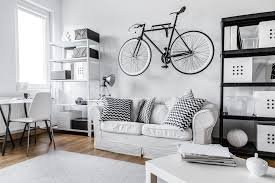Maximizing Small Spaces: Smart Home Decor Tips for Apartments

1. Embrace Multi-Functional Furniture
When space is limited, every piece of furniture should work harder. Multi-functional furniture not only saves room but also provides extra storage or versatility.
-
Sofa beds or daybeds can transform your living room into a guest room.
-
Storage ottomans can serve as seating, coffee tables, and a place to stash blankets or books.
-
Drop-leaf tables or nesting tables provide flexibility for dining or entertaining without taking up constant space.
-
Beds with built-in drawers are ideal for storing clothes, linens, or seasonal items.
Tip:
Choose furniture with hidden storage or convertible features. It reduces clutter and increases usability.
2. Use Vertical Space
When floor space is at a premium, go vertical! Wall-mounted shelves, tall bookcases, and hanging storage can dramatically increase your usable space without crowding the room.
-
Install floating shelves above sofas, desks, or beds.
-
Use tall cabinets instead of wide ones to conserve floor area.
-
Hang hooks or pegboards for keys, bags, hats, or kitchen tools.
-
Consider ceiling-mounted racks or hanging planters for a modern, airy look.
Tip:
Keep vertical storage visually light by choosing open shelving or items in neutral colors to avoid overwhelming the room.
3. Choose Light Colors and Reflective Surfaces
Light colors naturally make spaces feel larger and more open. Pale shades reflect light, which creates the illusion of depth and brightness.
-
Stick to whites, creams, soft grays, and pastel tones for walls and large furniture pieces.
-
Add mirrors to reflect light and expand the feel of the room.
-
Use glossy or metallic finishes for decor, lighting, or furniture accents.
Tip:
Place a large mirror opposite a window to double the amount of natural light in the room and give the illusion of a bigger space.
4. Keep the Layout Open and Uncluttered
Overcrowding a small apartment with too much furniture or decor can make it feel cramped. Instead, focus on creating a functional flow through the space.
-
Choose smaller-scale furniture that fits the room, rather than trying to squeeze in full-size pieces.
-
Leave clear walkways between furniture to make the space feel more open.
-
Use rugs to define different areas in a studio or open-plan apartment (e.g., living, sleeping, dining zones).
Tip:
Stick to a minimal approach—only keep what you use and love. Less visual clutter means more mental clarity and a feeling of space.
5. Incorporate Smart Storage Solutions
Storage is often the biggest challenge in a small apartment, but smart planning can solve that.
-
Use under-bed storage bins or risers to create more room beneath your bed.
-
Install over-the-door organizers in closets or bathrooms.
-
Get stackable storage boxes or drawer units that can fit into tight spaces.
-
Opt for bench seating with built-in storage in entryways or dining nooks.
Tip:
Label your storage bins to stay organized and make it easier to find what you need quickly.
6. Opt for Foldable or Stackable Pieces
Being able to tuck things away when not in use can make your apartment feel bigger and more flexible.
-
Use folding chairs or tables for guests or dining.
-
Invest in collapsible laundry baskets, drying racks, or ironing boards.
-
Stackable stools or nesting tables can be stored compactly and pulled out only when needed.
Tip:
Look for pieces that are lightweight and easy to move around so you can adapt your space for different uses.
7. Use Curtains and Dividers Strategically
Curtains aren’t just for windows—they can be a powerful tool for dividing space and adding privacy in small apartments.
-
Use ceiling-mounted curtains to create a bedroom nook in a studio.
-
Install a folding screen or room divider to visually separate your workspace or sleeping area.
-
Opt for sheer or light fabric to maintain a feeling of openness.
Tip:
If possible, hang curtains from ceiling to floor to add the illusion of height, making your space feel larger.
8. Create Visual Continuity
A disjointed space can feel smaller than it actually is. Visual continuity—achieved through color, material, or style—can make your apartment feel more cohesive and expansive.
-
Use a consistent color palette throughout the apartment.
-
Match finishes on your hardware (e.g., brass handles, chrome fixtures).
-
Repeat materials like wood, metal, or linen across different rooms.
Tip:
Avoid mixing too many bold patterns or textures. Stick to one or two accent patterns and blend them with solids for a balanced look.
9. Add Plants for Life and Freshness
Greenery makes a small space feel more vibrant and inviting. Plants also improve air quality and provide a soothing connection to nature.
-
Use hanging planters, wall-mounted pots, or narrow plant stands to conserve space.
-
Choose low-maintenance indoor plants like pothos, snake plants, or succulents.
-
A small herb garden in the kitchen window can be both beautiful and useful.
Tip:
Use a few larger plants instead of many small ones to reduce visual clutter while still getting the benefits of greenery.
10. Personalize with Purpose
Finally, don’t forget to make your apartment feel like home. Just because it’s small doesn’t mean it should feel impersonal.
-
Display artwork, photos, or keepsakes that bring you joy.
-
Use stylish storage boxes, baskets, or trays to contain everyday items.
-
Incorporate textiles like throw pillows, rugs, or blankets for warmth and personality.



